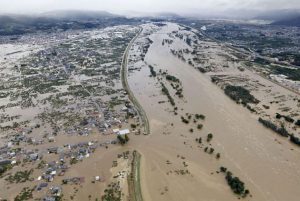 Japan sent tens of thousands of troops and rescue workers on Sunday to save stranded residents and fight floods caused by one of the worst typhoons to hit the country in recent history, which killed 18 people and briefly paralysed Tokyo.
Japan sent tens of thousands of troops and rescue workers on Sunday to save stranded residents and fight floods caused by one of the worst typhoons to hit the country in recent history, which killed 18 people and briefly paralysed Tokyo.
There were also 13 people missing, public broadcaster NHK said, as Typhoon Hagibis left vast swaths of low-lying land in central and eastern Japan inundated and cut power to almost half a million homes.
Landing restrictions at Tokyo’s Narita and Haneda airports were lifted but more than 800 flights were cancelled for the day, NHK said, as were some Shinkansen bullet train services to the worst-hit areas.
Authorities lifted rain warnings for the Kanto region around a becalmed Tokyo, where stores reopened and many train lines resumed operations, but they warned there was still the risk of rivers in eastern Japan overflowing and inflicting fresh damage.





